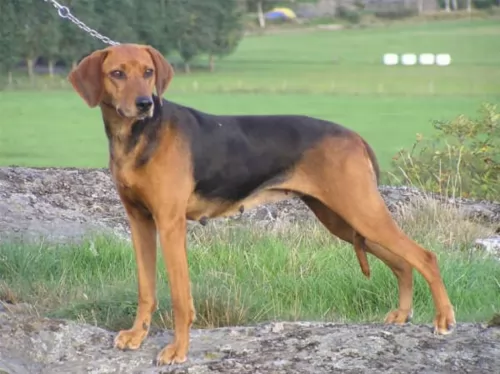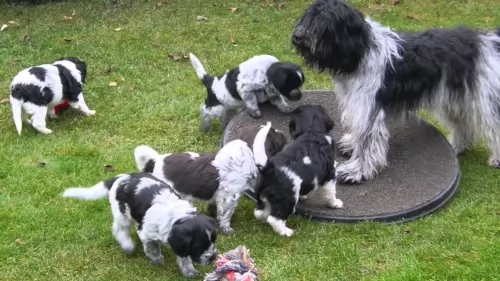 MyDogBreeds
MyDogBreeds Schillerstovare is originated from Sweden but Schapendoes is originated from Netherlands. Schillerstovare may grow 11 cm / 5 inches higher than Schapendoes. Both Schillerstovare and Schapendoes are of same weight. Both Schillerstovare and Schapendoes has same life span. Both Schillerstovare and Schapendoes has almost same litter size. Schillerstovare requires Low maintenance. But Schapendoes requires Moderate maintenance
Schillerstovare is originated from Sweden but Schapendoes is originated from Netherlands. Schillerstovare may grow 11 cm / 5 inches higher than Schapendoes. Both Schillerstovare and Schapendoes are of same weight. Both Schillerstovare and Schapendoes has same life span. Both Schillerstovare and Schapendoes has almost same litter size. Schillerstovare requires Low maintenance. But Schapendoes requires Moderate maintenance
 The Schillerstövare originated in Sweden, being named after a Swedish farmer, Per Schiller. After he died, the dog was named Schillerstövare in 1907, and was Sweden's first native dog breed.
The Schillerstövare originated in Sweden, being named after a Swedish farmer, Per Schiller. After he died, the dog was named Schillerstövare in 1907, and was Sweden's first native dog breed.
The Swedish Kennel Club recognised this dog in 1907 and it is also recognised by the Federation Cynologique Internationale as well as a number of minor kennels and dog clubs.
The dog has always been used as a hunting dog and the English Foxhound is the e foundation for this breed.
 Known also as the Dutch Sheepdog, the Schapendoes originates in the Netherlands.
Known also as the Dutch Sheepdog, the Schapendoes originates in the Netherlands.
It has always been known as a herding dog and farm dog. There were times during the 1940s when the dog’s numbers dropped considerably, but fortunately a breed club known as the Nederlandse Schapendoes was formed in 1947.
It wasn’t until 1971 that the dog earned recognition as a Dutch breed and the Federation Cynologique Internationale recognized this Dutch Sheepdog in 1989.
 The Schillerstövare is a medium to large sized dog. They’re athletic and muscular.
The Schillerstövare is a medium to large sized dog. They’re athletic and muscular.
Standing at between 53–61cm in height and weighing in the region of 18–25kg, the coat of the dog is fairly short and harsh, with the color being black and tan.Sometimes you’ll see some white markings on the chest and paws.
The head is domed, the eyes brown, bright and alert and the ears of the dog are broad, medium length and floppy. The long tail is carried low or held out when running or alert.
If you allow your Schillerstovare to have puppies, you can expect between 3 to 7.
The Schillerstovare is a calm dog but he can get petty lively when there’s a game to be had. He gets on well with well disciplined children who have been taught to be kind and respectful to animals. He also gets on well with pets in the home. Just like with most other dogs, he will need to be trained and socialized as he is a strong willed, confident, dominant dog.
He is friendly and active but will be somewhat reserved around strangers.These dogs will require a lot of exercise and will need quite a bit of space too. They aren't well suited to small properties in the city. He will need a daily walk but also a chance to get off his leash and run free in the park. Other forms of exercise such as hikes, ball game and swimming will delight him.
 The Schapendoes is a medium sized herding dog standing at between 40 and 50cm in height and weighing between 12 and 25kg.
The Schapendoes is a medium sized herding dog standing at between 40 and 50cm in height and weighing between 12 and 25kg.
When you look at him, you’re reminded of the Old English Sheepdog or the Bearded Collie. The thick, double coat of the dog can be a mix of colors and can be brown and white, black and white and gray and a mix of all these colors.
In spite of the thick coat, the dog sheds very little. He is an active dog and is known to be able to jump high. This makes him perfect for ball and frisbee games as he will leap into the air to try and catch the ball.
He has medium length floppy ears and the tail is long and feathered, carried high when busy, but when he is relaxed the tail hangs low.
Brave, cheerful,social and loyal, the Schapendoes is a shaggy Dutch dog who makes a splendid pet and companion for active people.
He is intelligent too, and in fact it is why he makes such a great farm dog too as he is able to work on his own and co-operates with his owner. He just loves being active, and will happily join you on all your hikes, runs on the beach, swimming, walks and other activities.
He thrives on being counted in as one of the active family members. This intelligence of his makes him easy to train and socialize, making him well mannered and obedient.
His amicable nature allows him to get on with all well disciplined children as well as with other pets in the home.
 Schillerstovares are social, loving, friendly, loyal dogs who enjoy being around their human family. He’s going to need a lot of exercise, both mental and physical to keep him from boredom and frustration.
Schillerstovares are social, loving, friendly, loyal dogs who enjoy being around their human family. He’s going to need a lot of exercise, both mental and physical to keep him from boredom and frustration.
He will rely on you for at least a daily walk. He is strong-will and confident and will do well in a family where they are active and where they are firm, patient, kind and consistent in their behaviour towards him because then he ticks all th right boxes for being a splendid pet.
 Because this dog has always been a working dog, he has learned to be independent.
Because this dog has always been a working dog, he has learned to be independent.
They’re eager to please their owners and easy to train too. They’re not aggressive and are friendly and affectionate and want to protect their owners.
They’re cheerful and playful and are tolerant of children and pets in the home. However, they don’t want little children being allowed to climb over them.
You can expect these big cuddly dogs to make loyal, devoted pets when treated with love, care, kindness and respect.
 Even though your Schillerstovare is a healthy dog breed, hip dysplasia is a common dog disease that many dogs get.
Even though your Schillerstovare is a healthy dog breed, hip dysplasia is a common dog disease that many dogs get.
This is a skeletal disease when a dog’s hip joints become partially dislocated. It can be very difficult for your dog to get around, and he can also develop arthritis. It gets very sad when your dog doesn’t even want to participate in games anymore.
 Your Schapendoes is a generally healthy breed and with good food, a good amount of exercise and plenty of love and care, he can reach the ripe age of 15 or so.
Your Schapendoes is a generally healthy breed and with good food, a good amount of exercise and plenty of love and care, he can reach the ripe age of 15 or so.
Every dog however, has the potential to get one of the many canine diseases there are. Some of these canine diseases to look out for include hip dysplasia, dental problems, eye diseases, bloat, cancer and others.
Some people think that problems with teeth are mild – nothing to worry about and yet bad teeth can affect the quality of life for your pet.
Problems with the pet’s teeth usually start with a build- up of plaque that leads to tartar. This can lead to gingivitis and then periodontal disease can develop. Dogs can have bad teeth and this can affect organs in the body.
Problems with the teeth can be serious and your veterinarian will need to do an oral checkup and dental cleaning. If your dog has oral problems, you may notice bad breath, loose teeth, dribbling, tartar on the teeth and pawing at the mouth.
 With his short coat, the Schillerstovare is considered a low maintenance dog and requires a minimal amount of grooming. Brushing should be done twice a week to remove loose hair. The harsh outer coat seems to repel dirt and dust.
With his short coat, the Schillerstovare is considered a low maintenance dog and requires a minimal amount of grooming. Brushing should be done twice a week to remove loose hair. The harsh outer coat seems to repel dirt and dust.
Trim your pet’s nails, check inside his ears for signs of redness, make sure his eyes are bright and clear and make sure he doesn’t have any unusual lumps on him.
Make sure his vaccines are up to date to avoid deadly canine diseases. Take him to the vet when you suspect he isn’t his normal self.
Dogs, just like humans, do well on good, nutritious diets. Feed a human lots of junk food and sweets and they’ll grow up to be obese and unhealthy. That's exactly how it is with dogs too. Some of the best commercially manufactured dog foods are convenient and they can be good if you look at the top brands. Look for ones that cater for your dog’s age, size, breed and activity levels. This dry kibble can be made more inviting for your pet when you include some homemade food.
Dogs just want simplicity so that they don’t battle with digestive problems. Boiled chicken, sweet potatoes, brown rice or pasta, carrots and spinach will be wonderful for him when you chop the food up and add it into the dry kibble twice a week. See his tail wag and his brown eyes light up when he smells this treat. Some raw meat added up occasionally will also contribute to your pet’s heath.
Make sure he is never without a constant supply of fresh, cool water.
 The Schapendoes has a dense double coat which can become quite long in places. The hair is slightly waved and there is quite a lot of hair around the face which includes a mustache and beard.
The Schapendoes has a dense double coat which can become quite long in places. The hair is slightly waved and there is quite a lot of hair around the face which includes a mustache and beard.
He will need to have his hair brushed twice a week, and some people choose to have him professionally clipped.
Trim his nails, check inside the ears for ear infection, check that the eyes are nice and clear without discharge, check inside the mouth for rotten teeth and check him over for any unusual lumps.
Your Schapendoes is an active dog and you want to ensure that the food you buy him keeps him active and healthy.
It is important to choose the best dog food if you buy commercially manufactured dog food. Then you can be sure it will have the right formulation of vitamins and minerals.
Home-made food is also an excellent choice for your pet. Boiled chicken, brown rice or pasta and spinach, sweet potatoes and carrots can be very healthy and tasty. Keep it simple like this. Chop it all up and add it into the dry kibble a couple of times a week to give him a nutritious treat.
Some raw meat added in occasionally will do him the world of good and keep the skin and coat healthy. Never leave your pet without a constant source of fresh, cool water.